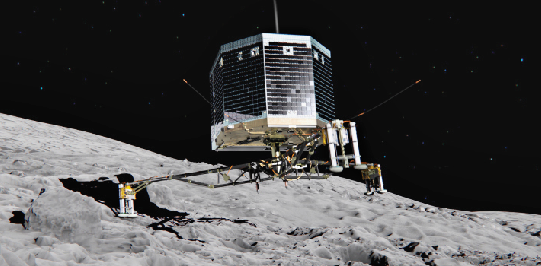Ever since Rosetta beamed back its first images of Comet 67P, scientists have wondered what made its unexpected double-lobed “rubber duck” shape. Now, they have an answer. According to a paper published October 15 in Nature, two separate objects collided to form the comet. To reach this conclusion, the researchers measured how regions were sloped, looked at the orientations of features on the surface, and calculated the local gravity across the surface.
Rosetta also has returned thousands of images of Comet 67P. It has photographed boulders balancing on just a small part of their surfaces, piles of rubble that seem to have come from falling rocks, and jets of gas spewing from pits dozens of feet across possibly created by sinkholes. The spacecraft also has spied about 120 bright areas several feet wide on the comet’s surface, and scientists say these are most likely patches of water ice reflecting sunlight.
After analyzing data of one water-ice patch on the comet’s “neck,” scientists say the area seems to appear and disappear with the comet’s 12-hour rotation. They think that as the region feels direct sunlight, ice on the surface and just an inch (a few centimeters) below are heated and turn directly to gas — a process called sublimation. The sunlight also warms the layers of ground beneath the region, and so further-buried ice makes its way as gas to the surface. As the patch rotates into darkness, the surface cools again and the just-risen gas turns to ice. The scientists, who reported this water cycle in the September 24 issue of Nature, say the process repeats each cometary day.
Rosetta’s refrigerator-sized Philae lander had also studied the comet’s surface, even though the sequence of events to land this spacecraft didn’t go as planned. After dropping from Rosetta on November 12, 2014, and bouncing several times before finally tumbling to rest, Philae stayed alert for just around 60 hours before falling into hibernation. Because of its unplanned bounces, the lander was able to compare two different sites on the comet’s surface. The first landing site appears to have a soft dusty material about 8 inches (20cm) thick covering a much harder material, possibly icy or crystalline in nature. Philae’s final resting spot, however, lacks that dusty coating.
At the first landing location, the craft “smelled” 16 organic compounds, including four never before detected on a comet. Another instrument detected several gases at the same location, like water vapor, carbon monoxide, and formaldehyde. Comets are expected to be pristine relics from the early solar system, but Comet 67P has more complex chemistry than expected, and some of the molecules discovered on the comet’s surface are important for biology.
After hibernating for seven months, Philae surprised everyone when it woke up again June 13. Over the next few weeks, Philae and Earth had spotty conversations, with the last command sent and received July 9. Scientists have no way to know whether Philae still sits atop Comet 67P, or whether it has been pushed off by actively spewing jets of gas.
Rosetta will continue watching Comet 67P through September 2016, at which point mission scientists will most likely try to land the spacecraft on the comet for a last look.










